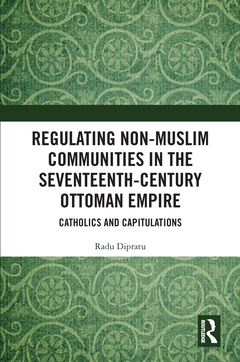Regulating Non-Muslim Communities in the Seventeenth-Century Ottoman Empire Catholics and Capitulations

This volume investigates how the peace and trade agreements, better known as capitulations, regulated Catholics in the Ottoman Empire.
As one of the many non-Muslim groups that made up Ottoman society, Catholic communities were scattered around the Empire, from the Hungarian plains to the Aegean Islands and Palestine. Besides the more famous cases of the French capitulations of 1604 and 1673, this work explores the evolution of often ignored religious privileges granted by the Ottoman sultans to the Catholic rulers of Venice, the Holy Roman Empire, and Poland-Lithuania, as well as to the Protestant Dutch Republic and Orthodox Russia. While focused on the seventeenth century, precedents of the fifteenth century and later developments in the eighteenth century are also considered. This volume shows that capitulations essentially addressed the presence and religious activities of Catholic laymen and clerics and the status of churches. Furthermore, it demonstrates that European translations, the primary sources of previous scholarly works, offered a flawed perspective over the status of Catholics under Muslim rule.
By drawing heavily on both original Ottoman-Turkish texts and previously unpublished archival material, this volume is an ideal resource for all scholars interested in the history of Catholicism in the seventeenth-century Ottoman Empire.
Introduction Part 1: The evolution of religious issues in Ottoman capitulations 1. The first ones on the scene: French capitulations 2. The old acquaintances: Venetian capitulations 3. The bitter rivals: Habsburg capitulations 4. The latecomers: Polish-Lithuanian capitulations 5. The Protestant and Orthodox Cases Part 2: Pilgrims, clerics, and churches in the Ottoman capitulations 6. Catholic laymen 7. Priests, Monks and Missionaries 8. The status of churches 9.Conclusions
Radu Dipratu is a historian at the Institute for South-East European Studies of the Romanian Academy in Bucharest. His main research topics are Ottoman diplomatics and Catholics in the Ottoman Empire in the early modern age, on which he has written several articles such as ‘Visiting the Noble Jerusalem: Catholic Pilgrims in the Ottoman Capitulations of the Seventeenth Century’ (2018) and ‘The Valona Affair (1638), its Ensuing Anti-Piracy nişan and the Development of Ottoman-Venetian Peace Agreements’ (2020).
Date de parution : 09-2023
15.6x23.4 cm
Date de parution : 09-2021
15.6x23.4 cm
Thème de Regulating Non-Muslim Communities in the... :
Mots-clés :
Religious Article; Catholic communities; Holy Sepulchre; French capitulations; Noble Jerusalem; Catholicism; Mehmed IV; Ottoman Empire; Murad III; Capitulations; Murad IV; Religious Privileges; Grand Vizier; Catholic Clerics; Osman II; Ottoman Hungary; Venetian Bailo; Mehmed II; Dar Al Harb; Religious Provisions; Selim II; Ahmed III; Holy Roman Empire; De La Croix; Ivan III; Savary De; Unmentioned Faith; Sultan Mehmed IV; Patrona Halil



